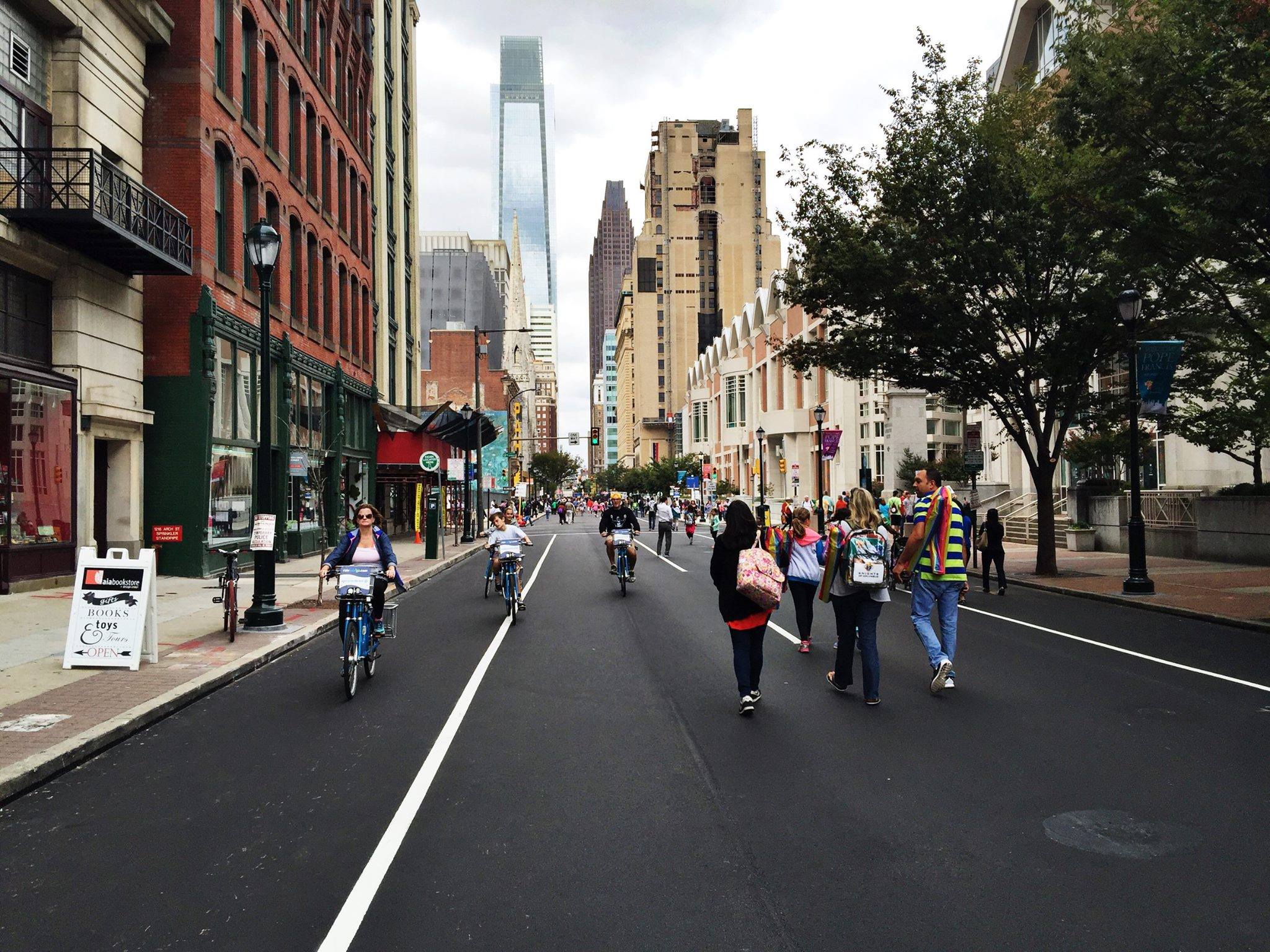Guest Blog: Open Streets PHL on Philly Free Streets

Cities across the world are finding success in combating poor air quality, climate change and their related health impacts with car-free days. Last year, Paris went as far as to ban vehicles in 30% of their city. As a result, nitrogen dioxide, a harmful air pollutant, dropped by 40% in parts of the city. On Butler Street in Pittsburgh, air pollution registered four times lower during their car-free event called OpenStreetsPGH. This year, on September 24th, Philadelphia will be partaking in its first designated car-free event, known as Philly Free Streets. So, what exactly is a car-free day, how will it look in Philadelphia and what are the other benefits? We’ll let the folks at Open Streets PHL, a nonprofit behind the local movement for open streets, explain:
What if we opened our streets to people for walking, cycling, playing and socializing by simply closing them off to cars for a few hours?
It’s called Open Streets and it’s a way to bring life and energy back to Philadelphia’s most underutilized public space — our city streets.
Open Streets initiatives temporarily close streets to automobiles so that people may use them for healthy and fun physical activities. Today, there are more than 100 Open Streets initiatives in the United States and Canada alone.
Many North American Open Streets organizers originally drew inspiration from Central and South American cities, where these initiatives are often called “Ciclovía.” The word Ciclovía literally translates to “bike path,” and was coined in Bogotá, Colombia when the city introduced the program in 1974. With nearly 70 miles of streets open for non-motorized activity each Sunday and holiday and 1 million participants on a weekly basis, Bogotá is an admirable leader of this growing global movement.
Open streets programs are increasingly popular because their goals align with the challenges that cities and towns face related to public health, economic growth, and the environment. Every open streets program follows the same principles: encourage physical activity; allow participants to reimagine their communities as places to walk and bike for transportation; improve air quality by removing cars from the road; and encourage people to frequent businesses and fuel local economies.
Philadelphia’s Open Streets movement grew out of the city’s experience with Pope Francis’s visit in September 2015. As part of the security preparations, the city closed down streets all throughout Center City and some of the surrounding neighborhoods.. Though the street closures created a disruption that negatively impacted many residents and business owners, many people also realized how much they enjoyed our public streets in the absence of motor vehicles.
Parents played in the street with their children; men and women ran, cycled, and walked along corridors typically clogged with cars; and people of all ages came out to enjoy a space both familiar and brand new. Philadelphia residents were energized by the feeling of freedom that comes with open streets.
The advocacy group Open Streets PHL formed in the wake of the Pope’s visit with the aim of creating an open streets program in Philadelphia. We worked closely with City transportation staff to refine the concept, and to provide them with a playbook that served as a how-to guide for hosting these events.
Thanks to the advocacy of Open Streets PHL, the city of Philadelphia will host its first Open Streets event, called Philly Free Streets, on Saturday, September 24th, 2016 from 8:00 AM to 1:00 PM, exactly one year after Pope Francis’ visit.
How Philadelphians decide the use 7 miles of open streets on the 24th is anyone’s guess, but we do have a pretty good idea of what some of the benefits will be.
They’ll get exercise — in other cities, over 90% of participants meet their recommended daily physical activity and nearly 40% get the recommended weekly activity in just a single day. They’ll also connect with the community– 25% of participants in Fort Collins, CO said they attended to strengthen community ties and nearly 90% in St. Louis, MO said they had a more positive view of their city after attending Open Streets.
We also know from open streets programs in other cities that businesses along the route benefit tremendously from all the foot traffic during the event, and from all the additional eyes on their storefronts. In San Diego, CA over 80% of participants shopped or ate at stores along the route and also said they planned to make return visits. St. Louis reported similar outcomes, with over 80% of participants spending some money, and nearly 70% becoming aware of a new store or restaurant they hadn’t seen previously.
We’re expecting similarly positive results from the first Philly Free Streets program in September. This inaugural event will transform the streets from Front & South to the Schuylkill River Trail and Dr. Martin Luther King, Jr. Drive, all the way up to Parkside and West Fairmount Park.
The city team planning Philly Free Streets, led by the Mayor’s Office of Transportation and Infrastructure Systems, has announced that the 7+ mile route will include free, family-friendly fitness activities, as well as educational programming about the City’s waterways, public art, architecture, environment, and cultural resources.
A route map for the September 24th Philly Free Streets program and the Open Streets PHL playbook can be found at http://openstreetsphl.com.
Authored by: LeeAnne Mullins and the Open Streets PHL team

